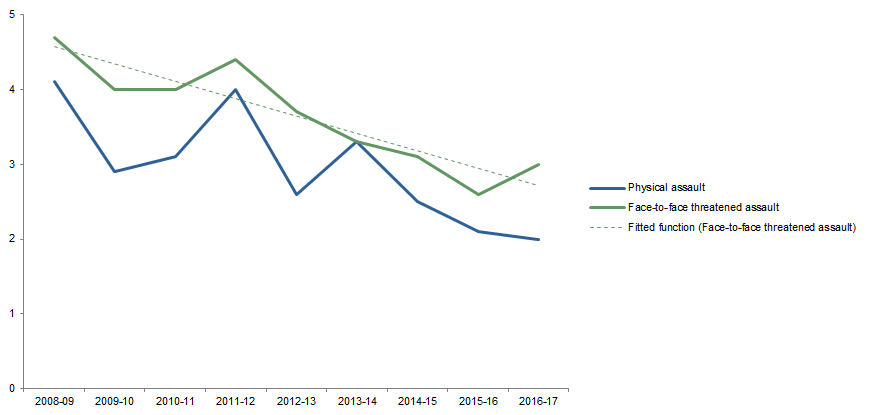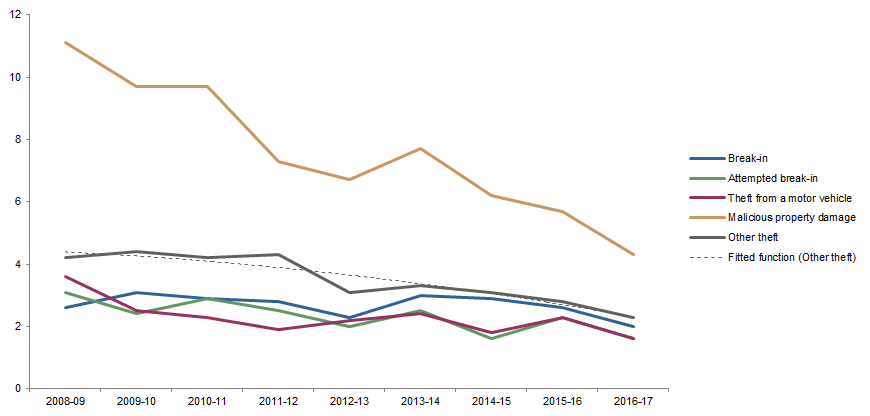TASMANIA
HOW HAVE PERSONAL CRIME VICTIMISATION RATES CHANGED OVER TIME?
The fitted function analysis showed a decline in the victimisation rate for face-to-face threatened assault in Tasmania since 2008-09.
Although no fitted functions that met the inclusion criteria were identified for physical assault in Tasmania, when undertaking significance testing (comparing two time points) the victimisation rate for physical assault was significantly lower in 2016-17 (2.0%) compared to 2008-09 (4.1%)
VICTIMISATION RATES, Selected personal crimes, Tasmania, 2008-09 to 2016-17(a)(b)(c)

Australian Bureau of Statistics
© Commonwealth of Australia 2018.
Footnote(s): (a) The fitted functions used to analyse patterns of change in victimisation rates over time have not taken into account the survey error associated with the annual victimisation rates. This is expected to have limited impact on the analysis, as only survey estimates with RSEs of 25% or less were included in the analysis. For further information on survey error refer to the Technical Note. (b) Fitted function is face-to-face threatened assault is a linear function with equation y = 0.0001x2 - 0.2327x + 4.8048 RČ = 0.8338. (c) Data for non face-to-face threatened assault are not shown, as estimates for the number of persons experiencing non face-to-face threatened assault in the 12 months prior to interview are subject to high sampling error (for further details refer to the Technical Note).
HOW HAVE HOUSEHOLD CRIME VICTIMISATION RATES CHANGED OVER TIME?
The fitted function analysis showed a decline in the victimisation rate for other theft in Tasmania since 2008-09.
Although no fitted functions that met the inclusion criteria were identified for attempted break-in, theft from a motor vehicle, and malicious property damage, when undertaking significance testing (comparing two time points) the victimisation rate for attempted break-in was significantly lower in 2016-17 (1.6%) compared to 2008-09 (3.1%), as were the victimisation rates for theft from a motor vehicle (1.6% compared to 3.6%) and malicious property damage (4.3% compared to 11.1%).
No fitted functions that met the inclusion criteria were identified for break-in in Tasmania, nor was there any significant difference in the victimisation rate for break-in between 2008-09 and 2016-17.
VICTIMISATION RATES, Selected household crimes, Tasmania, 2008-09 to 2016-17(a)(b)(c)

Australian Bureau of Statistics
© Commonwealth of Australia 2018.
Footnote(s): (a) The fitted functions used to analyse patterns of change in victimisation rates over time have not taken into account the survey error associated with the annual victimisation rates. This is expected to have limited impact on the analysis, as only survey estimates with RSEs of 25% or less were included in the analysis. For further information on survey error refer to the Technical Note. (b) Fitted function for other theft is a polynomial function with equation y = -0.0186x2 - 0.0739x + 4.481 RČ = 0.8828. (c) Data for motor vehicle theft are not shown, as estimates for the number of households experiencing motor vehicle theft in the 12 months prior to interview are subject to high sampling error (for further details refer to the Technical Note).
 Print Page
Print Page
 Print All
Print All
 Quality Declaration
Quality Declaration